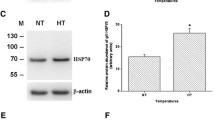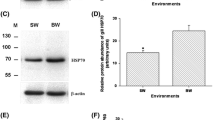Abstract
Regucalcin (RGN) is a calcium-binding protein mainly expressed in the liver. It functions in regulating activities of several calcium-dependent enzymes related to energy metabolism, antioxidant mechanisms, and apoptotic pathways. Previous proteomics analyses revealed downregulation of regucalcin in milkfish livers when acclimated to low temperature (18 °C) from normal temperature (28 °C). This study first identified the full-length sequence of milkfish regucalcin from the livers with high similarity in the protein structure and calcium-binding function compared to the regucalcin of other animals. The mRNA and protein expression of regucalcin in the livers of fresh water (FW)– and seawater (SW)-acclimated milkfish under hypothermal acclimation were further analyzed. In FW milkfish, upregulation of regucalcin was found in mRNA and protein levels from 2 to 4 days, respectively, to 1 week after transfer to 18 °C for the two. However, in SW milkfish, upregulation of regucalcin occurred quickly and returned to the basal levels in 1 (mRNA expression) or 2 days (protein expression) up until 1 week after transfer. These results suggested potential roles of regucalcin in maintaining calcium homeostasis and its correlation to differential physiological responses in the livers of milkfish when they were acclimated to FW and SW.






Similar content being viewed by others
Data availability
Not applicable
Code availability
Not applicable
References
Arboleda-Bustos CE, Segarra C (2011) The Dca gene involved in cold adaptation in Drosophila melanogaster arose by duplication of the ancestral regucalcin gene. Mol Biol Evol 28:2185–2195
Bayley JS, Winther CB, Andersen MK, Grønkjær C, Nielsen OB, Pedersen TH, Overgaard J (2018) Cold exposure causes cell death be depolarization mediated Ca2+ overload in a chill-susceptible insect. Proc Natl Acad Sci U S A 115:E9737–E9744
Chakraborti S, Bahnson BJ (2011) Crystal structure of human senescence marker protein 30: insights linking structural enzymatic and physiological functions. Biochemistry 49:3436–3444
Chang CH, Lo WY, Lee TH (2016a) The antioxidant peroxiredoxin 6 (Prdx6) exhibits different profiles in the livers of seawater- and fresh water-acclimated milkfish, Chanos chanos, upon hypothermal challenge. Front Physiol 7:580
Chang CH, Tang CH, Kang CK, Lo WY, Lee TH (2016b) Comparison of integrated responses to nonlethal and lethal hypothermal stress in milkfish (Chanos chanos): a proteomics study. PLoS One 11:e0163538
Chang CH, Lin JY, Lo WY, Lee TH (2017) Hypothermal stress induced differential expression profiles of the immune response gene, warm-temperature-acclimation associated 65-kDa protein (Wap65), in the liver of fresh water and seawater milkfish, Chanos chanos. Fish Shellfish Immun 70:174–184
Chang CH, Huang JJ, Yeh CY, Tang CH, Hwang LY, Lee TH (2018) Salinity effects on strategies of glycogen utilization in liver of euryhaline milkfish (Chanos chanos) under hypothermal stress. Front Physiol 10:81
Chang CH, Liu ZZ, Lee TH (2019) Changes in hypothermal stress induced hepatic mitochondrial metabolic patterns between fresh water- and seawater-acclimated milkfish, Chanos chanos. Sci Rep 9:18502
Chang CH, Wang YC, Lee TH (2021) Hypothermal stress-induced salinity-dependent oxidative stress and apoptosis in the livers of euryhaline milkfish, Chanos chanos. Aquaculture 534:736280
Cheng CH, Guo ZX, Wang AL (2018) The protective effects of taurine on oxidative stress, cytoplasmic free-Ca2+ and apoptosis of pufferfish (Takifugu obscurus) under low temperature. Fish Shellfish Immun 77:457–464
Ching B, Chew SF, Ip YK (2015) Ascorbate synthesis in fishes: a review. IUBMB Life 67:69–76
Das C, Thraya M, Vijayan MM (2018) Nongenomic cortisol signaling in fish. Gen Comp Endocrinol 265:121–127
Donaldson MR, Cooke SJ, Patterson DA, Macdonald JS (2008) Cold shock and fish. J Fish Biol 73:1491–1530
Fachry ME, Sugama K, Rimmer MA (2018) The role of small-holder seed supply in commercial mariculture in South-east Asia. Aquac. 495:912–918
Fujisawa K, Terai S, Hirose Y, Takami T, Yamamoto N, Sakaida I (2011) Senescence marker protein 30 (SMP30)/regulcacin (RGN) expression decreases with aging, acute liver injuries and tumors in zebrafish. Biochem Biophys Res Commun 414:331–336
Fujita T, Uchida K, Maruyama N (1992) Purification of senescence marker protein-30 (SMP30) and its androgen-independent decrease with age in the rat liver. Biochim Biophys Acta 1116:122–128
Fujita T, Shirasawa T, Inoue H, Kitamura T, Marutama N (1998) Hepatic and renal expression of senescence marker protein-30 and its biological significance. J Gastroenterol Hepatol 13:S124–S131
Fukaya Y, Yamaguchi M (2004) Regucalcin increases superoxide dismutase activity in rat liver cytosol. Biol Pharm Bull 27:1444–1446
Goto SG (2000) Expression of Drosophila homologue of senescence marker protein-30 during cold acclimation. J Insect Physiol 46:1111–1120
Izumi T, Yamaguchi M (2004) Overexpression of regucalcin suppresses cell death and apoptosis in cloned rat hepatoma H4-II-E cells induces by lipopolysaccharide, PD 98059, dibucaine, or Bay K 9644. J Cell Biochem 15:598–608
Jana SN, Garg SK, Patra BC (2006) Effect of inland water salinity on growth performance and nutritional physiology in growing milkfish, Chanos chanos (Forsskal): field and laboratory studies. J Appl Ichthyol 22:25–34
Kang CK, Chen YC, Chang CH, Tsai SC, Lee TH (2015) Seawater-acclimation abates cold effects on Na+, K+-ATPase activity in gills of the juvenile milkfish, Chanos chanos. Aquaculture 446:67–73
Kondo Y, Inai Y, Sato Y, Handa S, Kubo S, Shimodado K, Goto S, Nishikimi M, Maruyama N, Ishigami A (2006) Senescence marker protein 30 functions as gluconolactonase in L-ascorbic acid biosynthesis and its knockout mice are prone to scurvy. Proc Natl Acad Sci U S A 103:5723–5728
Liao IC (1991) Milkfish culture in Taiwan. In: McVey JP (ed) CRC handbook of mariculture volume II: finfish aquaculture. CRC Press, Boca Raton, pp 91–115
Linster CL, Schaftingen EV (2007) Vitamin C biosynthesis, recycling and degradation in mammals. FEBS J 274:1–22
Luo SW, Wnag WN, Cai L, Qi ZH, Wang C, Liu Y, Peng CL, Chen LB (2015) Effects of a Dissostichus mawsoni-CaM recombinant proteins feed additive on juvenile orange-spotted grouper (Epinephelus coioides) under the acute low temperature challenge. Fish Physiol Biochem 41:1345–1358
MacMillan HA, Knee JM, Dennis AB, Udaka H, Marshall KE, Merritt TJS, Sinclair BJ (2016) Cold acclimation wholly reorganizes the Drosophila melanogaster transcriptome and metabolome. Sci Rep 30:28999
Martinez FS, Tseng MC, Yeh SP (2006) Milkfish (Chanos chanos) culture: situations and trends. J Fish Soc Taiwan 33:229–244
Matsutama S, Kitamura T, Enomoto N, Fujita T, Ishigami A, Handa S, Marutama N, Zheng D, Ikejima K, Takei Y, Sato N (2004) Senescence marker protein-30 regulates Akt activity and contributes to cell survival in HepG2 cells. Biochem Bioph Res Co 321:386–390
Murata T, Yamaguchi M (1998) Ca2+ administration stimulates the binding of AP-1 factor to the 5’-flanking region of the rat gene for the Ca2+-binding protein regucalcin. Biochem J 329:157–163
Na Y, Changlian P, Deng C, Qiao H, Guanghui X, Fei G, Liangbiao C (2013) The over-expression of calmodulin from Antarctic notothenioid fish increases cold tolerance in tobacco. Gene 521:32–37
Oliva-Vilarnau N, Hankeova S, Vorrink SU, Mkrtchian S, Andersson ER, Lauschke VM (2018) Calcium signaling in liver injury and regeneration. Front Med 5:192
Park, J.K., Ki, M.R., Lee, H.R., Hong, I.H., Ji,A.R., Ishigami, A., Park, S.I., Kim, J.M., Chung, H.Y., Yoo, S.E., Jeong, K.S., 2010. Vitamin C deficiency attenuates liver fibrosis by way of up-regulated peroxisome proliferator-activated receptor-gamma expression in senescence marker protein 30 knockout mice. Hepatology 51, 1766-1777.
Vaz CA, Marques R, Cardoso HJ, Maia CJ, Socorro S (2016) Suppressed glycolytic metabolism in the prostate of transgenic rats overexpressing calcium-binding protein regucalcin underpins reduced cell proliferation. Transgenic Res 25:139–148
Verleih M, Rebl A, Köllner B, Korytár T, Anders E, Wimmers K, Goldammer T (2011) Comparative molecular characterization of the regucaclcin (RGN) gene in rainbow trout (Oncorhynchus mykiss) and maraena whitefish (Coregonus marena). Mol Biol Rep 39:4291–4300
Wang Z, Qu Y, Zhuo X, Li J, Zou J, Fan L (2019) Investigating the physiological responses of Pacific white shrimp Litopenaeus vannamei to acute cold-stress. Peer 7:e7381
Yamaguchi M (2011) The transcriptional regulation of regulation of regucalcin gene expression. Mol Cell Biochem 346:147–171
Yamaguchi M (2013) The anti-apoptotic effect of regucalcin is mediated through multisignaling pathways. Apoptosis 18:1145–1153
Yamaguchi M, Yamamoto T (1978) Purification of calcium binding substance from soluble fraction of normal rat liver. Chem Pharm Bull (Tokyo) 26:1915–1918
Funding
This work was partly supported by a grant to T.H. Lee from the Ministry of Science and Technology (MOST) of Taiwan (105-2313-B-005-027-MY3 and 108-2313-B-005-006-MY3) and in part by the integrative Evolutionary Galliform Genomics (iEGG) and Animal Biotechnology Center from The Feature Area Research Center Program within the framework of the Higher Education Sprout Project by the Ministry of Education (MOE) in Taiwan (109-S-0023-F). C.H.C. was supported by the postdoctoral fellowships from the MOST (108-2811-B-005-520).
Author information
Authors and Affiliations
Contributions
C.H.C conceived and designed this study and contributed to manuscript writing. T.H.L. reviewed and edited the manuscript. T.H.L. supervised the project. All authors read and approved the final manuscript for publication.
Corresponding author
Ethics declarations
Ethics approval
The experimental procedures were approved by the Institutional Animal Care and Use Committee (IACUC) of the National Chung Hsing University, Taichung, Taiwan (IACUC Approval No. 105-024 to THL).
Consent to participate
Not applicable
Consent for publication
All authors read and approved the final manuscript for publication.
Competing interests
The authors declare no competing interests.
Additional information
Publisher’s note
Springer Nature remains neutral with regard to jurisdictional claims in published maps and institutional affiliations.
Supplementary information
ESM 1
(DOCX 15 kb)
Figure S1.
The exon/intron organization of DNA sequences of regucalcin in teleosts. C. chanos: XM_030781347.1; I. punctatus: NM_001200368.2; C. auratus: XM_026257802.1; D. rerio: NM_205746.1; O. mykiss: NM_001246349.1; S. salar: XM_030409260.1; E. Lucius: NM_001304242.1; T. flavidus: XM_003966709.3; S. aurata: XM_030409260.1; O. latipes: XM_004084583.4; O. melastigma: XM_024265448.2. (JPG 909 kb)
Rights and permissions
About this article
Cite this article
Chang, CH., Lee, TH. Hypothermal effects on expression of regucalcin, a calcium-binding protein, in the livers of seawater- and fresh water–acclimated milkfish, Chanos chanos. Fish Physiol Biochem 47, 999–1010 (2021). https://doi.org/10.1007/s10695-021-00960-7
Received:
Accepted:
Published:
Issue Date:
DOI: https://doi.org/10.1007/s10695-021-00960-7




